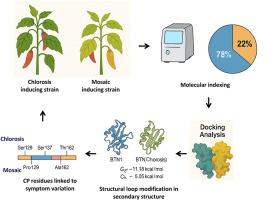辣椒中黄瓜花叶病毒两种不同菌株外壳蛋白的比较注释
IF 2.4
3区 医学
Q3 VIROLOGY
引用次数: 0
摘要
黄瓜花叶病毒(CMV)是一种全球流行的植物病毒,寄主范围广,严重影响辣椒作物。从诊断调查中,收集了49株有症状的辣椒,其中23株被确认为巨细胞病毒。分子指数分析显示,泰米尔纳德邦辣椒生态系统中CMV的嵌合诱导菌株(18个样本)占主导地位,而致绿诱导菌株(5个样本)则不同。将有代表性的菌株机械接种到辣椒寄主植株上,产生的症状与田间条件下观察到的相似。外皮蛋白(CP)基因与印度辣椒的同源性为97.65% ~ 98.92%,共657个核苷酸编码218个氨基酸。序列多样性分析表明,致绿变菌株具有较高的同义替换,表明核苷酸具有较大的变异性。氨基酸比较分析表明,在褪绿诱导菌株Ser129、Thr137、Thr162和嵌合诱导菌株Pro129、Ser137、Ala162中存在保守残基。此外,通过预测二级结构进行的CP注释显示了蛋白质环结构的构象改变。为了验证症状学,在前人研究的基础上,进行硅蛋白-蛋白对接,探讨辣椒叶绿体铁氧化还蛋白之间可能的相互作用。功能注释证实了变色症状的表达可能是由于Ser129的氨基酸变异,并有助于辣椒叶绿体铁氧还蛋白之间的相容相互作用。这些发现为菌株特异性症状发展的分子基础提供了新的见解,并强调了在辣椒栽培中对新出现的巨细胞病毒变异进行靶向诊断的必要性。本文章由计算机程序翻译,如有差异,请以英文原文为准。

Comparative coat protein annotation of two biologically distinct strains of cucumber mosaic virus in chili
Cucumber mosaic virus (CMV) is a globally prevalent plant virus with a broad host range, significantly affecting chili crops. From a diagnostic survey, 49 symptomatic chili plants were collected and CMV was confirmed in 23 samples. Molecular indexing revealed a predominance of mosaic-inducing strains (18 samples) along with distinct chlorosis inducing strains (5 samples) of CMV in the chili eco system of Tamil Nadu. Representative strains were mechanically sap inoculated onto chili host plants and produced similar symptoms as observed under field conditions. Coat protein (CP) gene analysis revealed 657 nucleotides encoding for 218 amino acids with a homology of 97.65 %–98.92 % with Indian chili isolates. Sequence diversity analysis indicated the higher synonymous substitutions in chlorosis-inducing strains, suggesting greater nucleotide variability. Comparative amino acid analysis indicated conserved residues in chlorosis-inducing strains such as Ser129, Thr137 and Thr162 and mosaic-inducing strains such as Pro129, Ser137 and Ala162. Furthermore, CP annotation performed by predicting secondary structures showed conformational modification in the loop structure of protein. To validate the symptomatology, in silico protein-protein docking was carried out to explore the possible interaction between chloroplast ferredoxin proteins of chili based on previous studies. Functional annotation substantiated that chlorotic symptom expression may be due to amino acid variation of Ser129 and aids compatible interaction between chloroplast ferredoxin proteins of chili. These findings provide novel insights into the molecular basis of strain-specific symptom development and highlight the need for targeted diagnostics of emerging CMV variants in chili cultivation.
求助全文
通过发布文献求助,成功后即可免费获取论文全文。
去求助
来源期刊

Virology
医学-病毒学
CiteScore
6.00
自引率
0.00%
发文量
157
审稿时长
50 days
期刊介绍:
Launched in 1955, Virology is a broad and inclusive journal that welcomes submissions on all aspects of virology including plant, animal, microbial and human viruses. The journal publishes basic research as well as pre-clinical and clinical studies of vaccines, anti-viral drugs and their development, anti-viral therapies, and computational studies of virus infections. Any submission that is of broad interest to the community of virologists/vaccinologists and reporting scientifically accurate and valuable research will be considered for publication, including negative findings and multidisciplinary work.Virology is open to reviews, research manuscripts, short communication, registered reports as well as follow-up manuscripts.
 求助内容:
求助内容: 应助结果提醒方式:
应助结果提醒方式:


